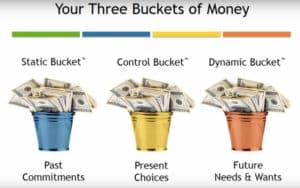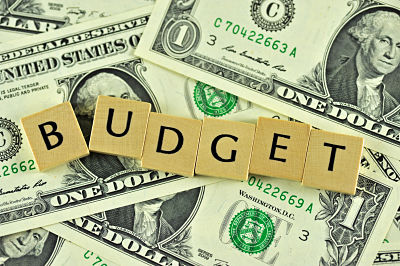What if there was a way to eliminate the pain of monthly tracking and keep the peace of mind that you are fulfilling your values and goals, would you do it?
Just saying the word “budget” is enough to cause your gut to wrench and make you feel guilty. Many academics professionals and journalists have told us that a budget is the cornerstone of financial success. Yet according to a recent Gallup poll, two thirds of Americans don’t have a budget, and I would guess that the one third that do aren’t all that excited about the process.
On top of being boring and time intensive, budgets remind us that our money is finite. They punish us for making purchases that seemed exciting at the time, but later turned out to conflict with our financial goals. What’s worse is that many affluent individuals earn so much income that they think budgeting is only for college students or newlyweds. The fact is that the benefits of budgeting are actually greater for individuals at their income level.
As a result, it is no surprise to me that money is cited as one of the top reasons for divorce in America. What if there was a way to eliminate the pain of monthly tracking? What if you had the peace of mind of knowing that you had an effective plan for fulfilling your values and goals, would you follow it?
My wife, Amy, and I were taught the First Step Cash Management System shortly after we married. We discovered it offers the most valuable financial advice anyone has ever given us. First Step was created by Marty Kurtz, CFP®, who carefully watched his clients’ spending habits and identified key themes among those who had the best handle on their cash flow. He learned that they seemed to “bucket” their money into three main categories: past commitments, present choices, and future needs and wants. Knowing what goes into each bucket and how to make related financial decisions can be life changing.
 The first bucket, called the Static bucket, is money spent on past commitments. These are regular payments that we make things like debts, insurance, taxes, services and and/or utilities. These are typically easy expenses to identify and critical to living within your means.
The first bucket, called the Static bucket, is money spent on past commitments. These are regular payments that we make things like debts, insurance, taxes, services and and/or utilities. These are typically easy expenses to identify and critical to living within your means.
A good place to start is to make sure that no more than half of your total annual take-home pay is spent on Static expenses. This has given Amy and me the framework for deciding how big of a house to buy, what trim level to choose on vehicles, and which services are the most important to us. Because ultimately this affects how much money we have left over for the next two buckets.
The second bucket is the Control bucket and it holds the money we spend on present-day purchases. These are the kinds of items we pull out our wallets or purses to pay for on the spot. They include things like groceries, gas, entertainment, dining, and personal care. Giving yourself a weekly cash allotment is one way to give yourself the freedom (within a set limit) to spend the money however you want.
Both Amy and I have our own control buckets. This means we each have each have our own money and we don’t judge each other on how we enjoy spending our money each week—as long as we’ve each taken care of any joint responsibilities first. A good place to start in finding the right amount of money to set aside in your Control bucket would be about 30% of your take home pay. Once you’ve figured out your total annual expenditures, you can divide that amount by 52 to get your weekly allotment instead.
The third bucket, the Dynamic bucket, is money reserved for future needs and wants. Beyond retirement and education savings, every month we set aside money in a savings account for things like travel, medical expenses, maintenance (i.e., house, cars, etc.), and charitable giving. In fact, we even name our savings accounts to remind us the importance of having our shared goals. We call our travel bucket the “Our Adventure” account, as creating life experiences for ourselves and family is extremely important to us.
Every month, as these accounts grow, we decide what types of experiences to plan for depending upon how much money we have set aside. This keeps us from putting things on credit cards and borrowing against our future income. We set aside approximately 20% of our monthly income for our dynamic expenses.
 You can make simple changes to your bank accounts that will enable you to take care of your financial commitments, help you live within your means, and reach your most important goals. The first step is setting up your cash flow. Have your income deposited into a master checking account and pay your static bills directly from that account. The secret sauce is in separating your personal spending funds from your bill-paying funds. Keep them in separate bank accounts.
You can make simple changes to your bank accounts that will enable you to take care of your financial commitments, help you live within your means, and reach your most important goals. The first step is setting up your cash flow. Have your income deposited into a master checking account and pay your static bills directly from that account. The secret sauce is in separating your personal spending funds from your bill-paying funds. Keep them in separate bank accounts.
Amy and I each have our own sub-checking account. We have set up a recurring automatic transfer of funds into our accounts at the same time each week. We then use those individual debit accounts to make our daily purchases and monitor our balances. Finally, we have money moved automatically every month from our master checking account into our Dynamic savings accounts. We use that money for things like plane tickets or home improvements.
Unlike traditional budgeting, once you have set up the First Step Cash Management System, there is very little need for review. We update ours when we have a change in income, are thinking about signing up for a service, preparing for a major expense, or simply want to review our life goals. This cash flow system almost runs itself. We just have to know which bucket an expense comes from and decide whether to spend the money. The rest is easy. Check out www.firststepcashmanagement.com to learn more. Good luck!
This post was re-posted on Forbes.com on October 9. Read the article again here!
 Andrew Sivertsen, CFP®, CeFT™, is a Partner and Sr. Financial Planner in the Quad Cities office of The Planning Center, a fee-only financial planning and wealth management firm. Email him at: andrew@theplanningcenter.com.
Andrew Sivertsen, CFP®, CeFT™, is a Partner and Sr. Financial Planner in the Quad Cities office of The Planning Center, a fee-only financial planning and wealth management firm. Email him at: andrew@theplanningcenter.com.






